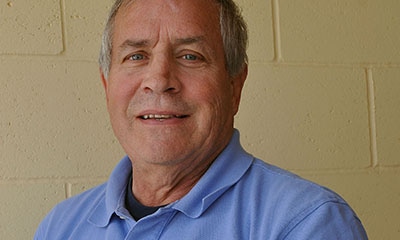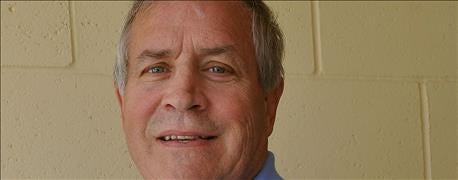January 21, 2016

The Sauk County agricultural community has lost a familiar face with the recent retirement of Rick Walgenbach, management agronomist at the U.S. Dairy Forage Research Center farm north of Prairie du Sac. Rick retired earlier this month after 26 years at the farm and 34 years with the Dairy Forage Research Center (USDA Agricultural Research Service).
Related: Dairy Robotic Tech Update set for N.Y. Farm Show

FARM WORK: In his 26 years at the U.S. Dairy Forage Research Farm, Rick Walgenbach is most proud of his efforts to improve the land.
Although his official title was "management agronomist," and his familiar title was "farm manager," a more apt title might be "the balancer." Like any farmer, he had to balance cropping and harvesting plans with the reality of the weather and other unpredictable events. But unlike most farmers, he also had to deal with the challenges of farming inside a locked ammunition plant, and with the unique requirements of operating a research facility.
The USDFRC farmland is part of the former Badger Army Ammunition Plant that was built on Sauk County farmland during World War II and also operated during the wars with Korea and Viet Nam. While the northern half of the plant was a huge industrial complex, the southern half remained fairly open with many of its former farm fields still intact. The land had been rented on and off to local farmers after WWII until 1980 when the USDFRC was created and it received a 20-year lease from the Army. Most of the leased land was within a fence that surrounded the plant.
For most of his time as farm manager, Walgenbach had to balance his farming needs with the security needs of the Army. Although ammunition was no longer being manufactured, the plant was on stand-by status and gunpowder was still being stored there. Until 2009, all farm vehicles and personnel going into the BAAP had to enter through a locked security gate. This included every load of manure, every full and empty forage wagon, every wagonload of hay or straw.
“Dealing with the Army’s need for security was frustrating. It definitely wasn’t a normal situation,” he says. “Looking back, I don’t know how we did it.”
Related: Applications for Dairy Calf and Heifer Association scholarship due Feb. 19
At the same time, Walgenbach is quick to point out that his relationships with the Army personnel were always good.
“Because the USDFRC farm is for research, Walgenbach also had to balance normal farm practices with the need to accommodate the research.
~~~PAGE_BREAK_HERE~~~
“Over the years the researchers asked me to plant a number of atypical crops, and sometimes we had to harvest crops earlier or later than normal to support the research,” he says.
He also had to ensile and store some crops separately from the general farm feed in order to study the ensiling process or to use the silage in feeding trials at a later date. “This is a farm, but it’s a farm that’s here to support research activities designed by the scientists. This definitely made the job more interesting for me. It’s fun to do something out of the ordinary and get it right.”
Related: Speakers headline Nebraska Dairy Convention February 2
One thing that most people don’t know about Walgenbach is that he was one of those USDFRC research scientists from late 1982 to 1990. As a research agronomist he studied forage management. One of the most significant findings of his research was that an alfalfa harvest late in the year may yield some extra feed, but the first harvest the next spring will be reduced by about the same amount; so the farmer doesn’t gain any yield but does have the added cost of that fall harvest. When he became the manager in 1990, all of the fields were tilled.
“Within a few years we converted almost all of the land to no-till and conservation tillage for improved soil conservation and labor efficiency,” he explains. “And we’ve maintained this no-till system ever since.”
He also implemented a nutrient management plan for the farm. “This plan helps us manage where manure should be spread based on nitrogen and phosphorus,” he says. “The goal is to get the manure nutrients to the crops that need it without over applying nutrients that could end up in runoff or leachate.” Nutrient management plans take into account soil test results, type of crop grown, crop rotations, nutrient content of the manure, and slope of the land, among other things. Weather is always the great unknown when writing these plans.
Another change Walgenbach made on the farm is to plant winter wheat in fields after they have been harvested for corn silage or soybeans. This acts as a soil cover crop during the winter months and is a good source of straw for bedding. He hasn’t specifically measured the positive effects of using cover crops, no-till and a nutrient management plan, but Rick is confident that these practices have made a difference. “I know that we have reduced soil erosion and maintained good crop yields while reducing the cost of fertilizing crops,” he says.
Walgenbach has been working on the farm and in research for his entire life. Born and raised on a farm near Fond du Lac, he was the second of six children.
“One of my jobs was to clean eggs for which I received a penny a dozen,” he recalls. Between his junior and senior year at UW-Madison he took a year off to run the farm while his father was recovering from a heart attack.
He graduated from the UW with a Bachelor's degree in agronomy in 1973; worked in the Agronomy Department for two years before pursuing a Master's degree in agronomy (1976); and went to the University of Minnesota to earn a PhD in agronomy in 1980. Walgenbach was an assistant professor of forage crops at the University of Illinois (25% teaching, 75% research) for two years before coming to the USDFRC.
He is very proud of his three daughters. Emilie earned a law degree and works for the Federal Reserve in New York City. Elizabeth is currently a PhD student at Yale University, but living in Iceland where she is conducting research for her thesis on medieval history and literature. Laura has a BFA in fashion design and runs her own Madison-based business, Pointelle design, which designs and manufactures knitwear.
In retirement, he plans to travel a bit so he can visit his daughters. He’s looking forward to being able to relax more, but he also has lots of house and yard projects to complete.
“And I’ll still stop out at the farm,” he admits. “I will probably do some part-time work there to help with the transition to the new manager.”
Source: USDFRC
You May Also Like




